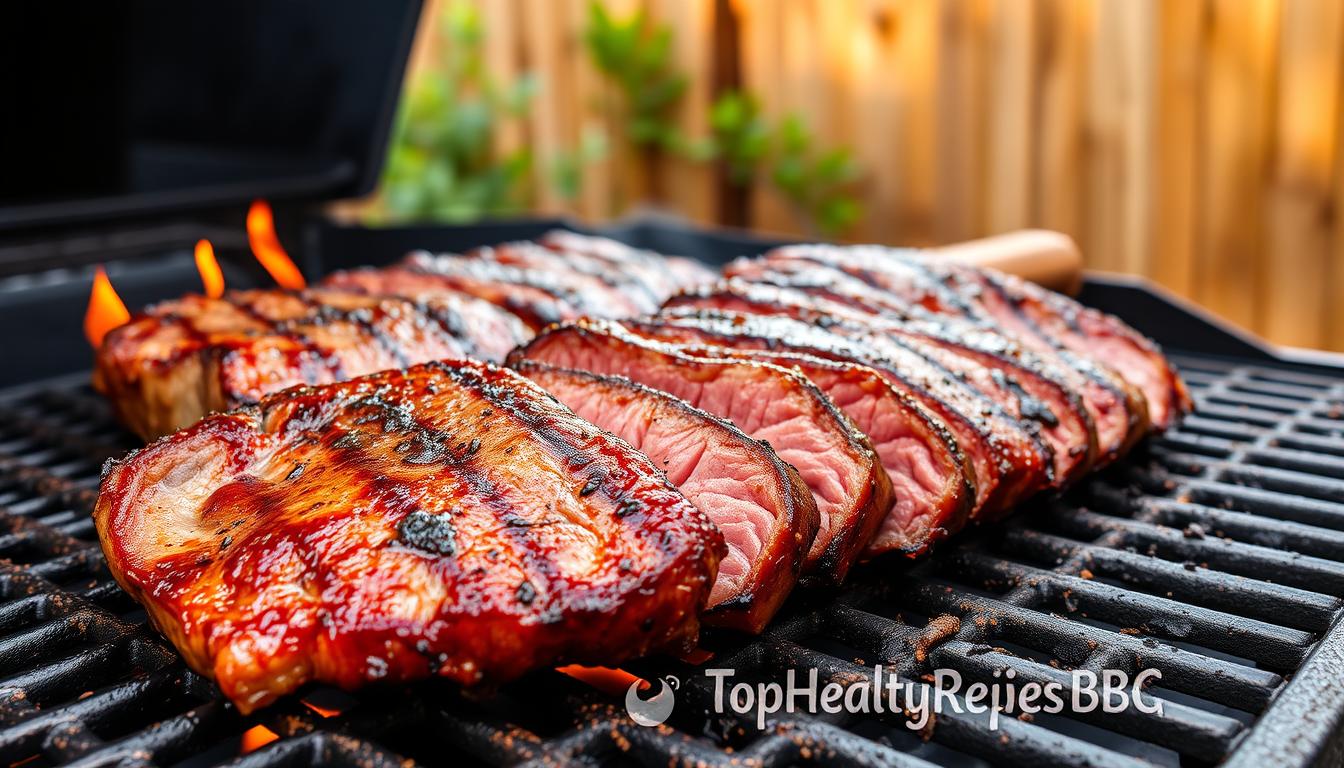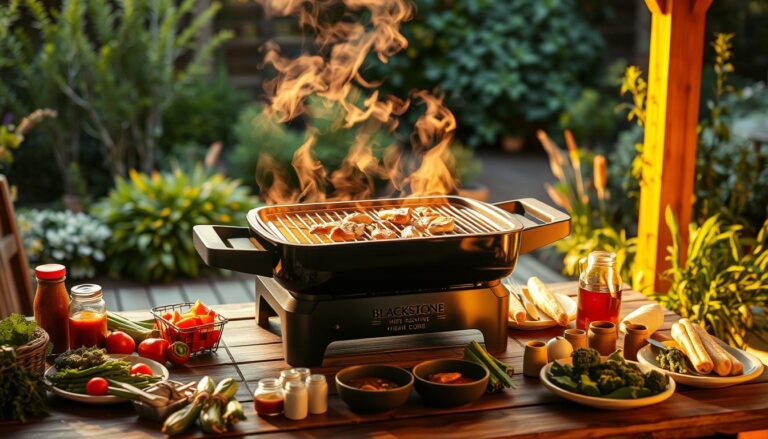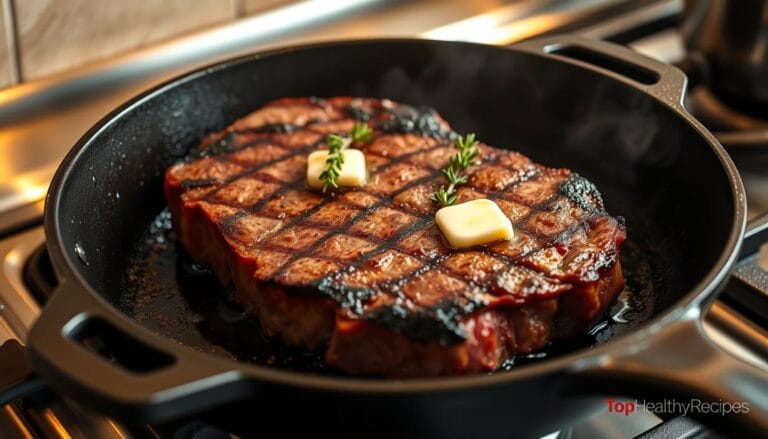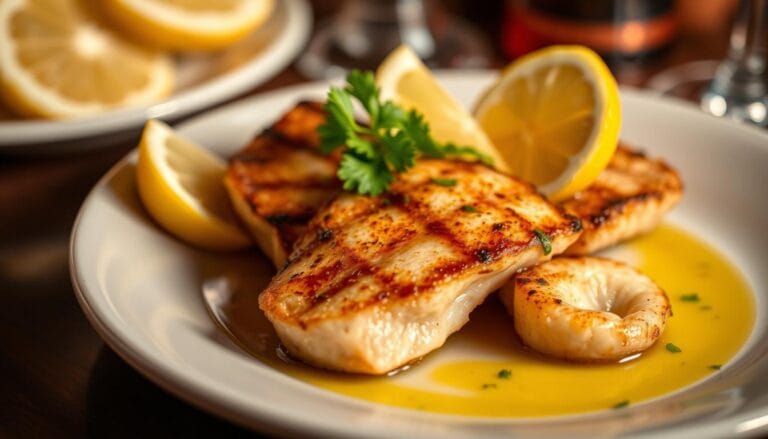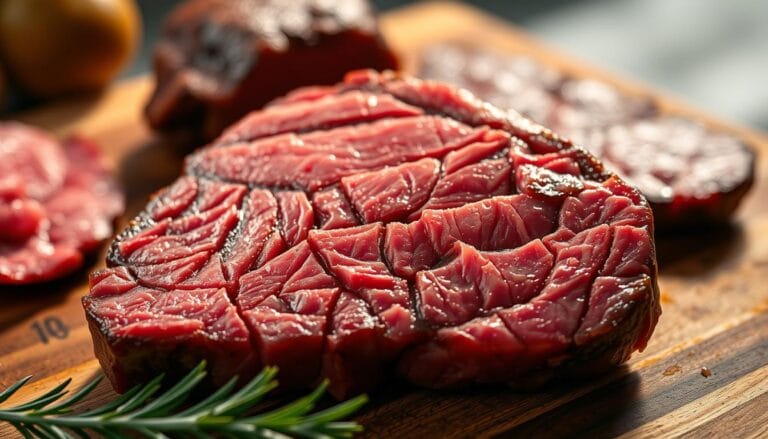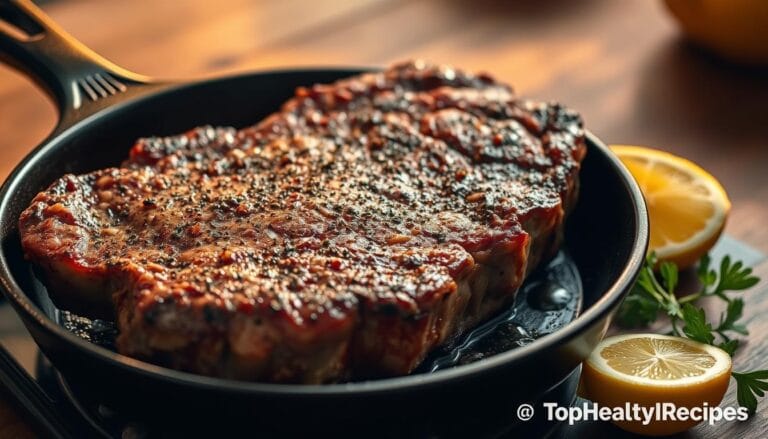Your Guide to Grilling Hanger Steak to Perfection
Table of Contents
Your Guide to Grilling Hanger Steak to Perfection
Imagine the sizzle of a perfectly grilled cut of beef. The aroma fills your backyard, and you can’t wait for that first bite. For many grill lovers, cooking hanger steak is a dream come true. It’s a cut that chefs love for its tenderness and rich flavor.
Starting your grilling adventure is exciting. You’ll learn to make a dish that’s both easy and fancy. Grilling hanger steak to perfection needs some skill. But with the right tips, you’ll impress your friends and family.
Key Takeaways
- Understand what makes hanger steak unique and flavorful.
- Learn how to select the perfect cut for grilling.
- Discover techniques for marinating and seasoning.
- Master the art of grilling to achieve perfect doneness.
- Explore ways to serve and pair your grilled hanger steak for a memorable meal.
What Is Hanger Steak? Understanding This Prized Cut
Hanger steak comes from the cow’s plate section, near the diaphragm. It’s known for its unique taste and texture. This cut is special because of where it’s located.
The Anatomy and Location of Hanger Steak
The hanger steak is near the kidney area. It’s small, weighing 1 to 2 pounds. It’s called the “hanging tender” because it looks like it’s hanging from the cow’s diaphragm.
Why It’s Called “Hanging Tender”
The name “hanging tender” comes from its location. It’s a tender cut that hangs between the rib and loin. This spot makes it tender and flavorful.
Single Cut vs. Divided Cut Presentation
Hanger steak can be served in two ways. It can be a single cut or divided into two pieces. The single cut keeps more juices, while the divided cut is better for marinating.
Why Hanger Steak Is Known as the “Butcher’s Secret”
Butchers used to keep hanger steak for themselves. They loved its rich flavor and tender texture. This made it a secret favorite among butchers.
Flavor Profile and Texture Characteristics
Hanger steak is known for its bold, beefy taste. It’s tender but also has a nice chew. Steak lovers love its intense flavor.
Comparing Hanger Steak to Other Cuts
Hanger steak is different from other steaks like flank or skirt steak. It’s more tender and flavorful than flat iron steak. Knowing these differences helps you pick the best steak for grilling.
Selecting the Perfect Hanger Steak
Finding the perfect hanger steak means knowing what to look for. At the butcher or grocery store, several factors are key. They ensure you get a great piece of meat.
What to Look for When Buying Hanger Steak
When buying hanger steak, look for certain signs. The quality of the steak greatly affects grilling and taste.
Color, Marbling, and Thickness Indicators
A fresh hanger steak should be a deep, cherry-red. Marbling, or the flecks of fat within the meat, adds flavor and juiciness. A moderate amount of marbling is best. The steak should be about 1 to 1.5 inches thick for even cooking.
- Color: Deep, cherry-red
- Marbling: Moderate
- Thickness: 1 to 1.5 inches
Fresh vs. Aged Hanger Steak
You might find fresh or aged hanger steak. Dry-aging concentrates flavors and tenderizes the meat. Fresh steak is common and flavorful, but dry-aged offers a more intense taste.
Grass-Fed vs. Grain-Fed: Which Is Better for Hanger Steak?
Grass-fed and grain-fed beef have their fans. Grass-fed steak is leaner and tastes “grassy” or “beefy.” Grain-fed steak is fattier, making it tender and juicy. Your choice depends on taste and nutritional preferences.
Where to Purchase Quality Hanger Steak
You can find quality hanger steak at butchers, online, or in grocery stores. Knowing the benefits of each helps you choose wisely.
Specialty Butchers vs. Grocery Stores
Specialty butchers offer a wide range of cuts and custom services. Grocery stores are convenient and often priced well. Both can provide great hanger steak, depending on what’s available.
Online Ordering Options
Online ordering is great for those without local sources. Many services deliver high-quality hanger steak right to your door. It’s a convenient way to find what you’re looking for.
Nutritional Profile of Hanger Steak
Looking into hanger steak’s nutrition shows it’s a great protein choice. Adding it to your meals can bring more than just taste to your plate.
Protein Content and Amino Acid Profile
Hanger steak packs about 20-25 grams of protein in every 3-ounce serving. This protein has all the amino acids your muscles need. It’s perfect for those who want to keep their muscles strong.
Fat Content and Composition
Even though hanger steak is leaner than some cuts, it has enough fat for flavor and moisture. It has a mix of different fats. Grass-fed hanger steak often has better fats than grain-fed.
Vitamins and Minerals in Hanger Steak
Hanger steak is full of vitamins and minerals, helping you meet your daily needs. It’s packed with B vitamins, like B12, which is good for your nerves and blood. It also has iron, zinc, phosphorus, and selenium, making it a healthy choice.
Some key nutritional highlights of hanger steak include:
- High-quality protein for muscle maintenance and growth
- A balanced fat profile contributing to flavor and nutritional value
- Rich in essential vitamins and minerals like B12, iron, and zinc
Essential Tools and Equipment for Grilling Hanger Steak
To get that perfect sear on your hanger steak, you need the right tools. The right equipment makes grilling easier and improves your dish’s quality.
Grill Types: Gas vs. Charcoal for Hanger Steak
The grill type affects your hanger steak’s taste. Gas grills are easy to use and control the heat well. They’re great for hanger steak’s quick cooking time. Charcoal grills, on the other hand, add a smoky flavor that pairs well with hanger steak’s strong taste.
- Gas Grills: Ideal for those who value ease of use and precise temperature control.
- Charcoal Grills: Perfect for those seeking to add a smoky flavor to their hanger steak.
Must-Have Grilling Accessories
Some accessories are key, no matter your grill type, for grilling hanger steak.
Meat Thermometers and Their Importance
A meat thermometer is vital for the right doneness. Hanger steak can quickly become overcooked. Digital and Bluetooth thermometers help you monitor it precisely.
Tongs, Spatulas, and Grill Brushes
Long-handled tongs are key for flipping the steak safely. Wide spatulas help with the steak’s shape. Quality grill brushes keep the grill clean, preventing sticking and creating great grill marks.
- Tongs: For safe flipping without losing juices.
- Spatulas: For supporting the steak during flipping.
- Grill Brushes: For maintaining a clean grill surface.
Preparing Your Hanger Steak Before Grilling
To get the most flavor out of your hanger steak, you need to prepare it right. This means following a few key steps. These steps make the steak tender and flavorful, and ensure it cooks well on the grill.
Trimming and Cleaning Your Hanger Steak
First, trim your hanger steak. This means removing any extra fat or tough parts. Trimming well makes the steak tender and better to eat. If your butcher didn’t do it, you’ll need to take out the tough middle part.
Removing the Central Membrane
The central membrane, or silver skin, can make the steak tough. To remove it, place the steak on a cutting board. Use a sharp knife to start at one end and gently pull it off. This might take some time, but it’s key for a tender steak.
Chef Jacques Pépin says, “Removing the membrane makes the meat tender and helps flavors spread evenly.”
“The membrane stops the meat from soaking up flavors and tenderizing evenly. By taking it out, your hanger steak will be tender and taste better.”
Effective Marinades for Hanger Steak
Marinades are important for flavor and tenderness. There are two main types: acid-based and oil-based.
Acid-Based Marinades
Acid-based marinades use vinegar, citrus, or wine to soften the meat. A simple one is:
- 1/2 cup of red wine vinegar
- 1/4 cup of olive oil
- 2 cloves of minced garlic
- 1 tablespoon of chopped fresh thyme
Coat your steak with this mix and let it marinate for 2 hours or overnight for deeper flavor.
Oil-Based Marinades
Oil-based marinades use oil, herbs, and spices for flavor. A basic one is:
| Ingredient | Quantity |
|---|---|
| Olive Oil | 1/2 cup |
| Minced Garlic | 3 cloves |
| Chopped Rosemary | 2 tablespoons |
| Salt | 1 teaspoon |
| Black Pepper | 1/2 teaspoon |
Brush this mix on your steak and let it sit for at least an hour before grilling.
Dry Rubs That Enhance Hanger Steak’s Flavor
Dry rubs offer a rich flavor without moisture. Mix salt, pepper, and spices for a great taste. For example, chili powder and cumin add smokiness, while garlic and herbs add aroma.
Bringing Your Steak to Room Temperature
Before grilling, let your steak warm up to room temperature. This helps it cook evenly. Just take it out of the fridge and let it sit for 30-45 minutes. This step greatly improves your grilled hanger steak.
The Ultimate Guide to Grilling Hanger Steak
Grilling a hanger steak is an art that, when done correctly, yields a flavorful and tender result. To achieve this, it’s essential to understand the various aspects of grilling this particular cut of meat.
Setting Up Your Grill for Hanger Steak
Before you start grilling, setting up your grill correctly is essential. For hanger steak, you’ll want to create a temperature zone on your grill. Preheat your grill to a high temperature, typically between 450-500°F. This high heat is key for achieving a nice sear on the steak. Make sure to clean and oil your grates to prevent the steak from sticking.
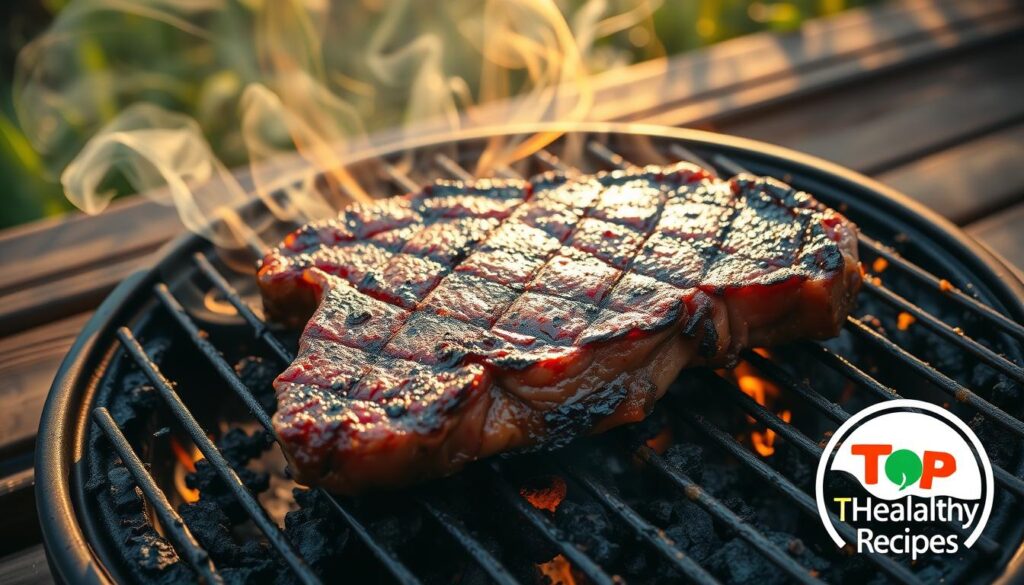
Temperature and Timing Guidelines
Cooking hanger steak to the right doneness is critical. The internal temperature you aim for depends on your preference for doneness. Here’s a general guideline:
| Doneness | Internal Temperature (°F) | Grilling Time (minutes per side) |
|---|---|---|
| Rare | 125-130 | 3-4 |
| Medium Rare | 130-135 | 4-5 |
| Medium | 140-145 | 5-6 |
| Medium Well | 150-155 | 6-7 |
| Well Done | 160-170 | 8+ |
Rare to Well-Done Temperature Chart
Refer to the temperature chart above to ensure you’re cooking your hanger steak to your desired level of doneness.
Direct vs. Indirect Heat Methods
The choice between direct and indirect heat depends on the thickness of your hanger steak and your desired outcome. Direct heat is ideal for searing the steak and creating a flavorful crust. For thicker steaks, starting with indirect heat can help cook the steak more evenly before finishing it off with a sear over direct heat.
How to Test for Doneness
There are multiple methods to check if your hanger steak is cooked to your liking. You can use the touch method, comparing the feel of the steak to different parts of your hand, or a meat thermometer for a more precise measurement. For hanger steak, it’s recommended to insert the thermometer into the thickest part of the steak.
Using Touch Method
The touch method involves touching the steak and comparing its feel to the flesh between your thumb and index finger when your hand is relaxed (rare), or when you touch your thumb to your pinky (well done).
Using a Meat Thermometer
A meat thermometer provides a precise internal temperature reading. For hanger steak, aim for the temperatures outlined in the temperature chart provided earlier.
The Critical Importance of Resting Your Steak
After grilling, it’s critical to let your hanger steak rest. This allows the juices to redistribute throughout the meat, making it more tender and flavorful. Typically, a resting period of 5-10 minutes is recommended. Keep the steak in a warm place, loosely covered with foil, to maintain its temperature without overcooking it.
Advanced Grilling Techniques for Hanger Steak
To improve your hanger steak grilling, try advanced chef techniques. These methods boost flavor, tenderness, and quality of your steak.
The Reverse Sear Method for Hanger Steak
The reverse sear method cooks the steak low first, then high-heat sears it. It ensures even doneness and keeps moisture in. Start by heating your grill to 225°F to 250°F.
Season your steak and put it on the grill, fat side up if it has one. Cook until it’s 10°F to 15°F below your desired doneness.
For medium-rare, this takes 30 to 40 minutes, depending on the steak’s thickness. Then, raise the grill heat to high. Use a hot skillet to sear the steak for 1 to 2 minutes each side. This adds a flavorful crust.
Using Wood Chips for Smoky Flavor
Wood chips can add smoky flavor to your steak. Soak them in water for 30 minutes before grilling. For gas grills, use a smoker box or foil with holes.
For charcoal grills, scatter the chips over the coals. This method enhances the steak’s taste.
Best Wood Types for Beef
- Hickory: Gives a strong, bacon-like flavor that’s robust and pairs well with hanger steak.
- Oak: Offers a sweeter, more subtle smokiness that complements beef without overpowering it.
- Mesquite: Has a strong, earthy flavor, perfect for those who like bold smoky tastes.
- Cherry: Adds a fruity, mild smokiness that balances the steak’s richness with sweetness.
Sous Vide and Grill Combination Technique
The sous vide method seals the steak in a bag and cooks it in a water bath. It ensures even cooking. Then, grill the steak to get a perfect sear.
For hanger steak, sous vide at 130°F to 135°F for medium-rare. Then, grill over high heat for 1 minute per side. This method gives a consistently cooked steak with a charred exterior.
Slicing and Serving Your Perfectly Grilled Hanger Steak
Slicing and serving your hanger steak right is key. It makes the meal better and more fun to eat.
The Correct Way to Slice Hanger Steak
To make your steak tender, slice it against the grain. First, find the muscle fibers’ direction. Look closely at the steak to see the lines.
Identifying the Grain Direction
After finding the grain, position your knife perpendicular to these lines. Cut the steak into thin strips, about ¼ to ½ inch thick. This makes the steak tender and easy to chew.
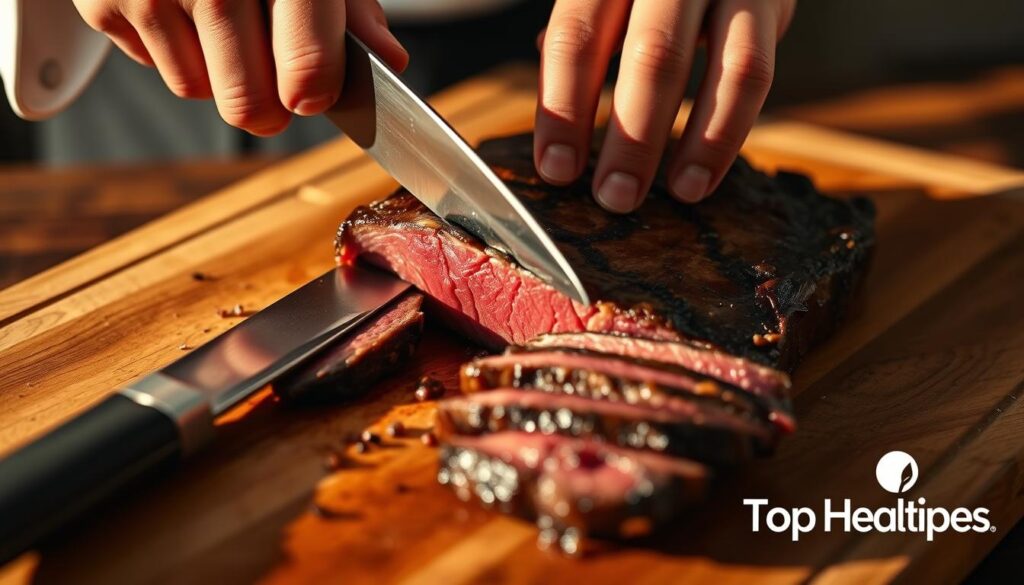
Complementary Sauces and Compound Butters
Add flavor to your hanger steak with sauces and butters. These can make the meal even better without hiding the steak’s taste.
Chimichurri Sauce Recipe
Make a tangy Argentinian chimichurri sauce. Mix parsley, oregano, garlic, red pepper flakes, red wine vinegar, and olive oil. It’s perfect with hanger steak.
Garlic-Herb Butter Recipe
Make garlic-herb butter by mixing softened butter with garlic, herbs, salt, and lemon juice. It melts over the steak, adding a rich flavor.
Ideal Side Dishes for Hanger Steak
Choose side dishes that match the steak’s strong flavor. Try roasted potatoes and grilled veggies. Or, go creative with blue cheese polenta or an arugula salad with parmesan.
By slicing and serving your steak right, you’ll make it even more enjoyable. It will be a memorable meal.
Troubleshooting Common Hanger Steak Grilling Problems
Hanger steak is known for its rich flavor but can be tricky to grill. Whether you’re new to grilling or experienced, knowing how to fix common issues can make your steak taste better every time.
Dealing with Tough or Chewy Results
Many people find hanger steak tough or chewy. This usually happens because of improper slicing, overcooking, or not letting it rest enough. To make it tender, slice it against the grain. Also, use a meat thermometer to avoid overcooking. Letting the steak rest for a few minutes helps the juices spread evenly.
If your steak is really tough, try marinating it. Use acidic ingredients like vinegar or citrus juice to tenderize the meat.
Fixing Uneven Cooking Issues
Hanger steak’s thickness can cause uneven cooking. To fix this, place thicker parts over lower heat. You can also use a two-zone fire setup to sear and then finish cooking. For very thick steaks, try butterfly cutting to make it even.
Preventing Flare-Ups When Grilling Hanger Steak
Hanger steak’s fat can cause flare-ups. To avoid this, trim excess fat before grilling. Make sure your grill is clean and well-oiled to prevent sticking. Keep water handy to put out flames. Grilling over indirect heat can also help prevent flare-ups.
Salvaging Overcooked Hanger Steak
If your steak is overcooked, don’t worry. You can use it in different ways. Slice it thinly for sandwiches or salads. Or, shred it for tacos or other dishes. You can also make a flavorful sauce by simmering it in stock or wine.
| Issue | Cause | Solution |
|---|---|---|
| Tough or Chewy Steak | Improper slicing, overcooking, inadequate resting | Slice against the grain, avoid overcooking, let steak rest |
| Uneven Cooking | Variable thickness | Strategic grill positioning, two-zone fire, butterfly cutting |
| Flare-Ups | High fat content | Trim excess fat, clean and oil grill, grill over indirect heat |
| Overcooked Steak | Overcooking | Slice thinly, shred for other dishes, make a flavorful sauce |
Regional and International Hanger Steak Preparations
Exploring global cuisines shows us many ways to cook hanger steak. This cut is loved for its rich taste and flexibility. It’s a favorite in French bistros and Latin American grill houses, where it’s cooked to highlight its unique qualities.
French Onglet Style Preparation
In France, onglet is a bistro favorite. It’s cooked with shallots, known as onglet à l’échalote. The steak is quickly seared, then a sauce is made with red wine, shallots, and butter. This brings out the steak’s flavors and adds a savory sauce.
Classic Bistro Preparation with Shallots
At a classic bistro, the steak is seasoned lightly to show off its quality. The shallot sauce is key, made by reducing red wine and mixing it with caramelized shallots and butter. This creates a deep, complex flavor that pairs well with the hanger steak.
Latin American Arrachera Techniques
In Latin America, hanger steak is called arrachera. It’s often marinated in vibrant flavors. The Mexican carne asada style is popular, with a marinade of citrus, chili peppers, and spices. The steak is grilled to get a charred outside and a juicy inside.
Mexican Carne Asada Style
For carne asada, the steak is marinated in lime juice, garlic, and chilies, then grilled. It’s served with cilantro, onions, and warm tortillas for a delicious meal.
Asian-Inspired Hanger Steak Recipes
Asian cuisines also have exciting ways to cook hanger steak. The Korean bulgogi style is one, with a marinade of soy sauce, sugar, sesame oil, and garlic. The steak is thinly sliced for tenderness and quick cooking.
Korean Bulgogi Adaptation
To make bulgogi-style hanger steak, slice the meat thinly, marinate it, and then grill or pan-fry it. This makes a tender, flavorful dish, often served with steamed rice and kimchi.
Conclusion: Mastering the Art of Grilling Hanger Steak
Now you know how to grill hanger steak like a pro. This beef cut is known for its rich taste and soft texture. It’s a must-have for any griller. To get it right, choose the best hanger steak, prepare it well, and grill it carefully.
Learning how to prepare hanger steak is essential. From trimming to marinating, and then grilling and slicing, each step matters. Try different marinades and cooking styles to find your favorite way to enjoy it.
As you get better at grilling hanger steak, don’t hesitate to try new things. Share your success with others. With time, you’ll be a pro at cooking this amazing beef cut. It will become a favorite in your grilling collection.
FAQ
What is hanger steak?
How do I trim and clean my hanger steak?
What’s the best way to marinate hanger steak?
How do I grill hanger steak to the right doneness?
How do I slice hanger steak correctly?
What are some common issues when grilling hanger steak, and how can I fix them?
Can I use hanger steak in international recipes?
How do I store leftover grilled hanger steak?
For more cooking tips, stay connected with us. We also recommend the cookbook Skinnytaste Simple: Easy, Healthy Recipes with 7 Ingredients or Fewer
For more Recipes about Steak ?
Did You try our recipe ?
There are no reviews yet. Be the first one to write one.
